Articulation #1 – Accent
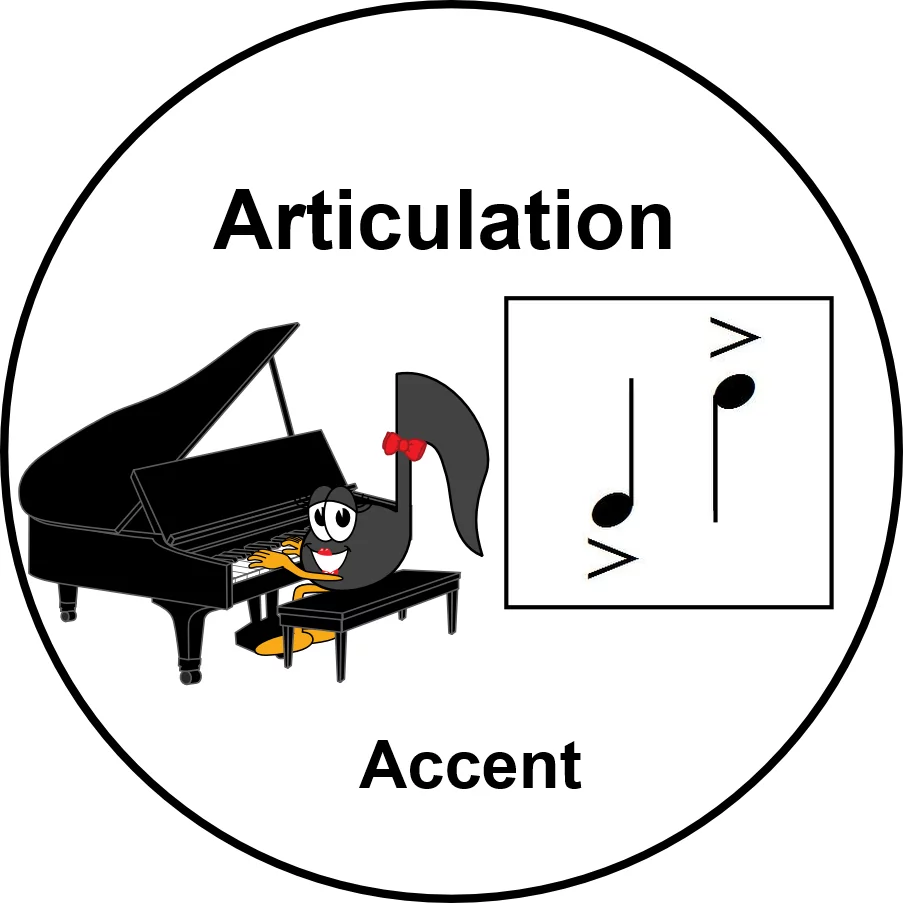
Articulation Signs tell us how to play a note. The Essential Dictionary of Music defines Articulation as "the manner in which notes are performed, such as staccato or legato". An Accent Sign (or Accent Mark) is the first Articulation that we are going to explore in this Blog Series.
The definition of an Accent is "to emphasize a note." When speaking, we usually emphasize a word by saying it louder - putting a vocal emphasis on it. When playing, we play the note/chord with the Accent by playing it louder, with more emphasis.
The Norton Manual of Music Notation defines an Accent as "a small wedge-shaped mark which indicates that individual notes or chords are to be played more boldly".
Let's explore the Accent - What is it? What does it look like? Where and how do we write it?
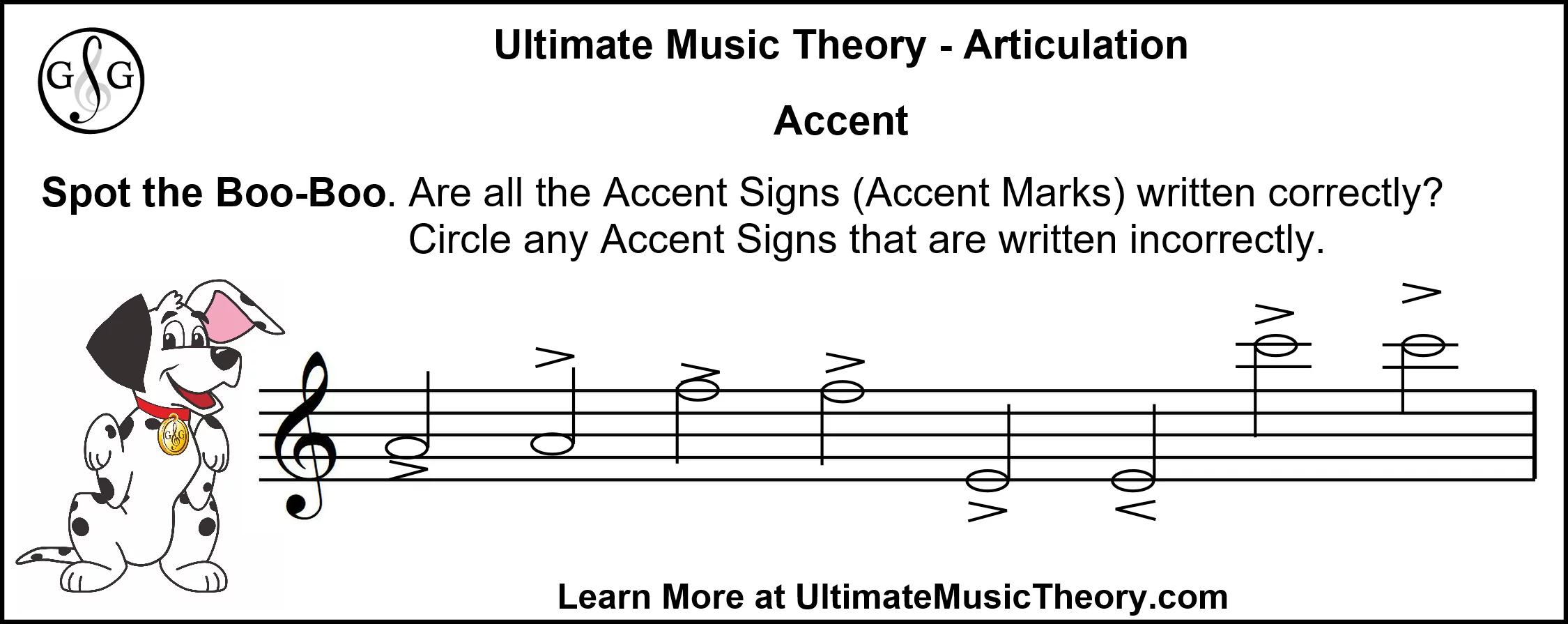
I love starting a Blog with a "Spot the Boo-Boo" Pop Quiz! Can you identify which Accent Signs (Accent Marks) have been written correctly (and which have not been written correctly)? How confident are you with your answers?
Actually, I learned a few new concepts while researching this blog! I wonder if you will discover something new too?
Articulation - Accent - What Does it Look Like?
The Accent Sign (Accent Mark) is two short lines open at one end and touching at the other. It is usually slightly larger (in width and height) than a notehead.
One of my Students has decided that, since it looks like a small diminuendo, it means the opposite - play it much louder!
What does an Accent look like? Here are 3 ideas:
- a "v" laying on it's left side;
- a very small diminuendo sign;
- a small mathematical "greater than" sign.
I would love to hear how else you would describe an Accent Sign to your Students? Do you have any memory tips or tricks?
When a stem is down, the Accent Sign is written above the notehead.
When a stem is up, the Accent Sign is written below the notehead.
An Accent Sign is never written "on" a line. It is always written in a space.
An Accent Sign never touches the notehead or the stem/beam either.
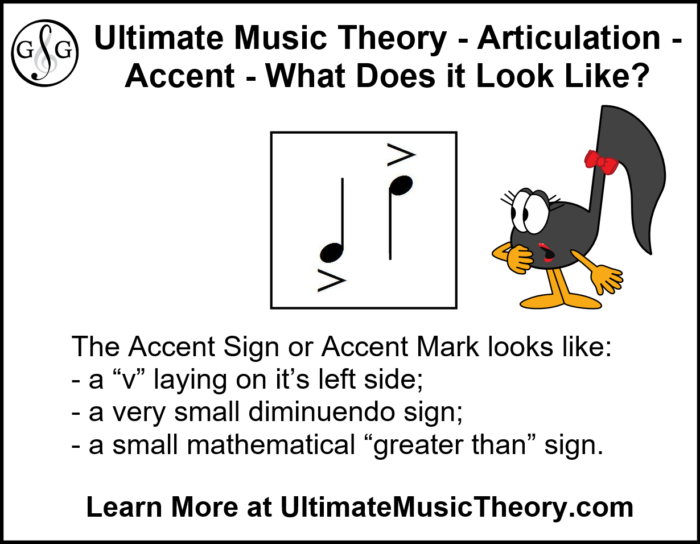
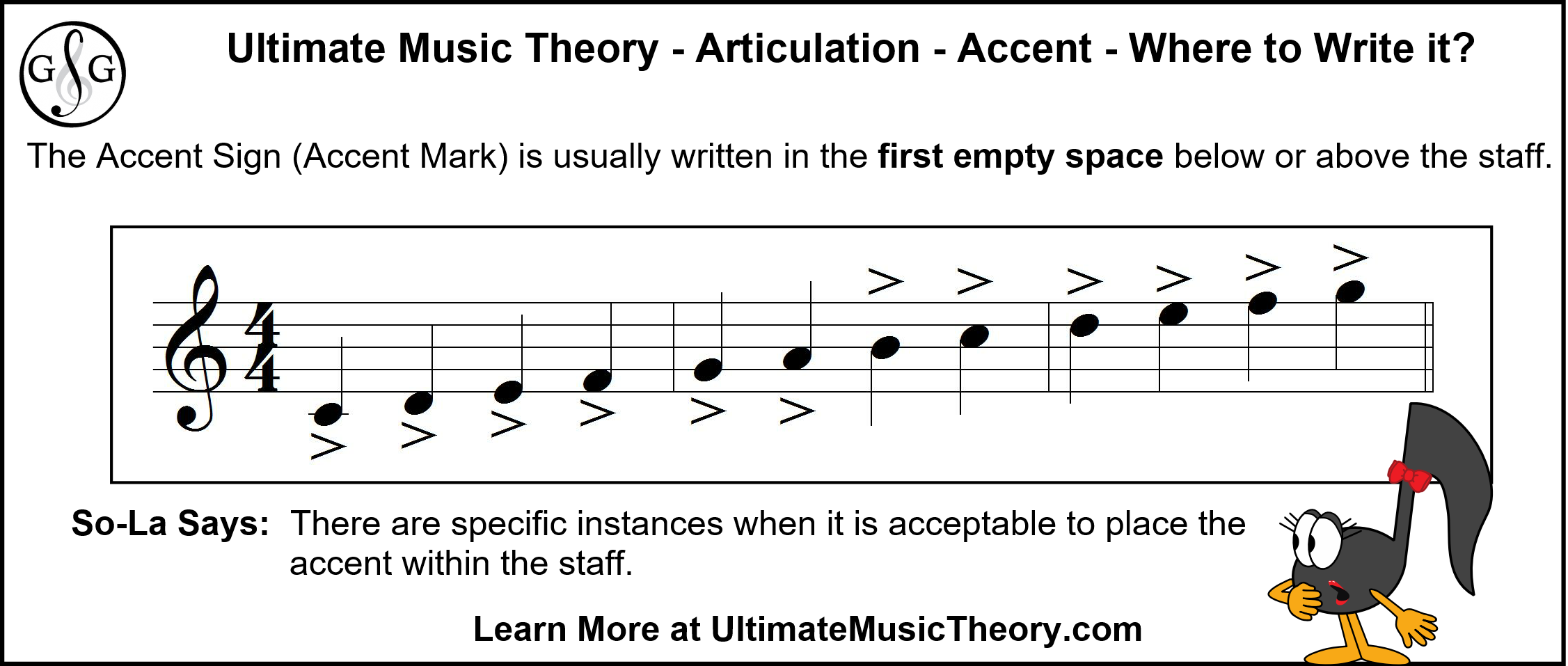
Articulation - Accent - What About Ledger Lines?
When a note is written on a ledger line, remember the exception to the Stem Rule - the stem of the note must be extended to touch Staff Line #3. This anchors the note to the staff.
You can read all about this in the Blog "Music Note Stem Length".
When writing an accented note on a ledger line, remember to:
- extend the length of the stem to touch Staff Line #3.
- write the accent above the notehead if the stem is down.
- write the accent below the notehead if the stem is up.
- never add a ledger line above or below the Accent Sign.
Do you notice how the Ledger Lines are all written evenly spaced - the same distance apart as the lines of the staff are written? This is important as Ledger Lines are an extension of the Staff. Teach your students how to use a ruler.
For more information on Ledger Lines, check out the blogs "Ledger Line Rules" and "Ledger Line Mistakes".
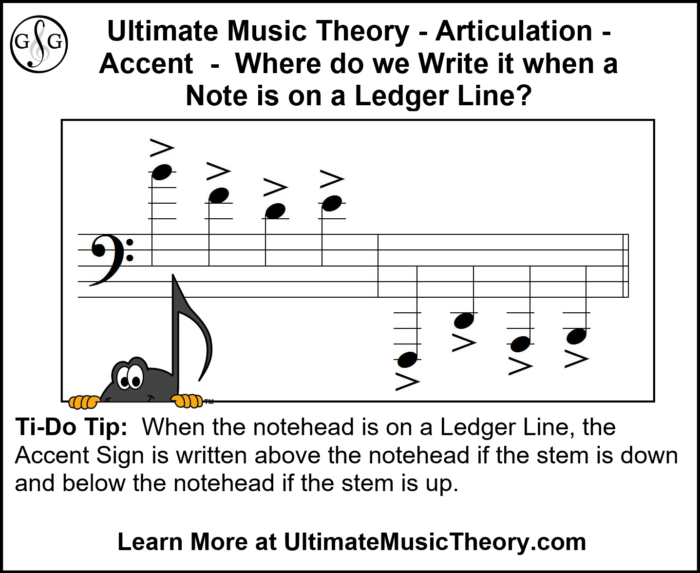
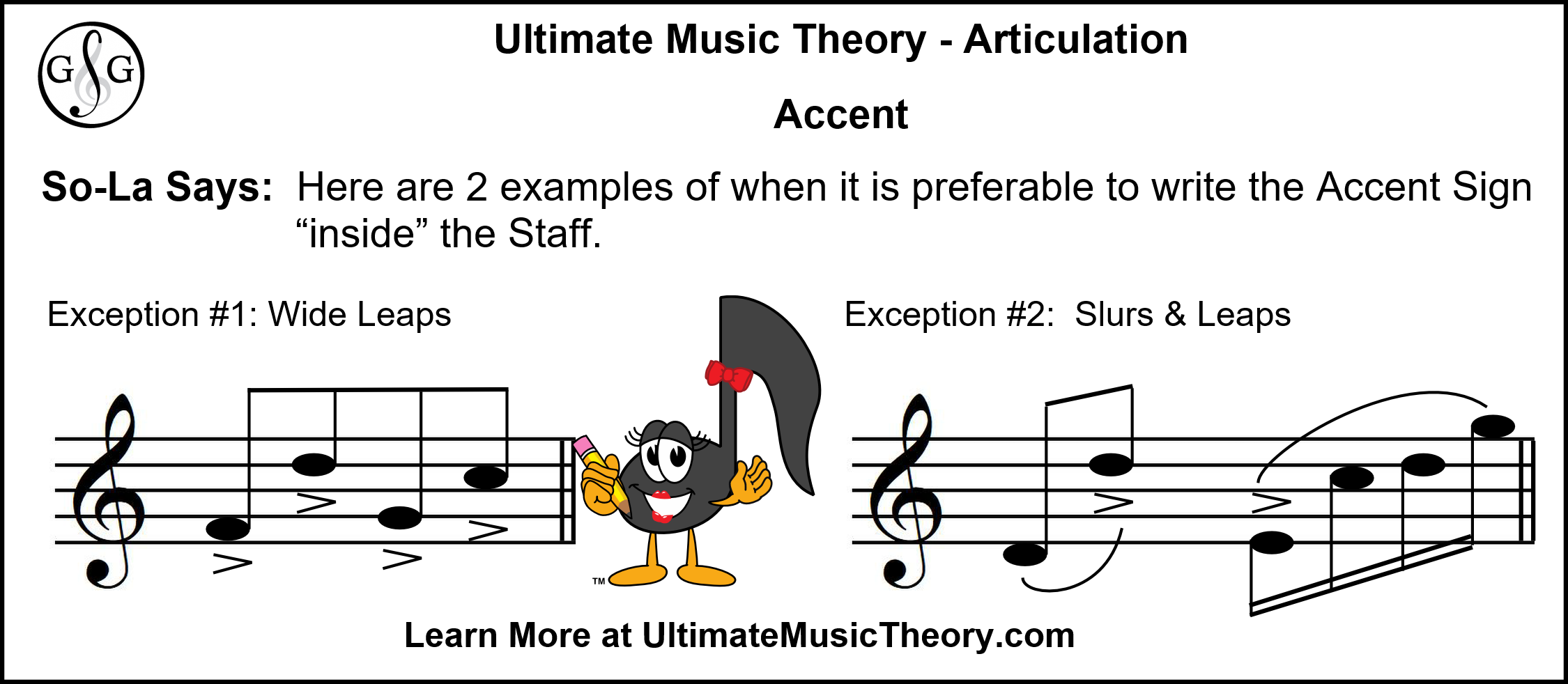
Articulation - Accent - The Exceptions to the Rule
I really do dislike having to teach "exceptions to the rules". Theory is usually correct or incorrect, with specific rules. In cases of beamed notes that have wide leaps between notes, it is PREFERABLE for the Accent to be written in the first empty space above or in the first empty space below the notehead.
A "wide leap" means that the interval is larger than a 4th, and (typically) the stem of the "exception" note is in the opposite direction from which it is normally written.
Using your Ultimate Music Theory Whiteboard, write the notes in the "Exception #1" example. Add all the accents in the space below the staff (for each note). What do you think? Does it look a bit weird? The recommended or preferred answer is to write the accent in the FIRST empty space below or above each notehead. This results in an accent being written inside the staff (but only when 2 or more notes are joined together, and are a wide leap apart that results in the stem being written in the opposite direction than normal). *Sigh* - exceptions can be so complicated.
Now let's write the notes in the "Exception #2" example. When adding a slur under or over beamed notes (that fall into the Exception #1 category), the accent sign must be written between the notehead and the slur. This again may result in a note having an accent written in the first empty space above or below the notehead.
Remember that "EMPTY" means that no part of the note (the notehead OR the stem) is in the space.
Remember that these exceptions are PREFERRED exceptions. This is the "new to me" concept that I discovered while researching this blog. This information is found on Page 51 in the book "The Norton Manual of Music Notation" - copyright 1987, First Edition published by W.W. Norton & Company Inc. This is one of my go-to books when I have a question about notation.
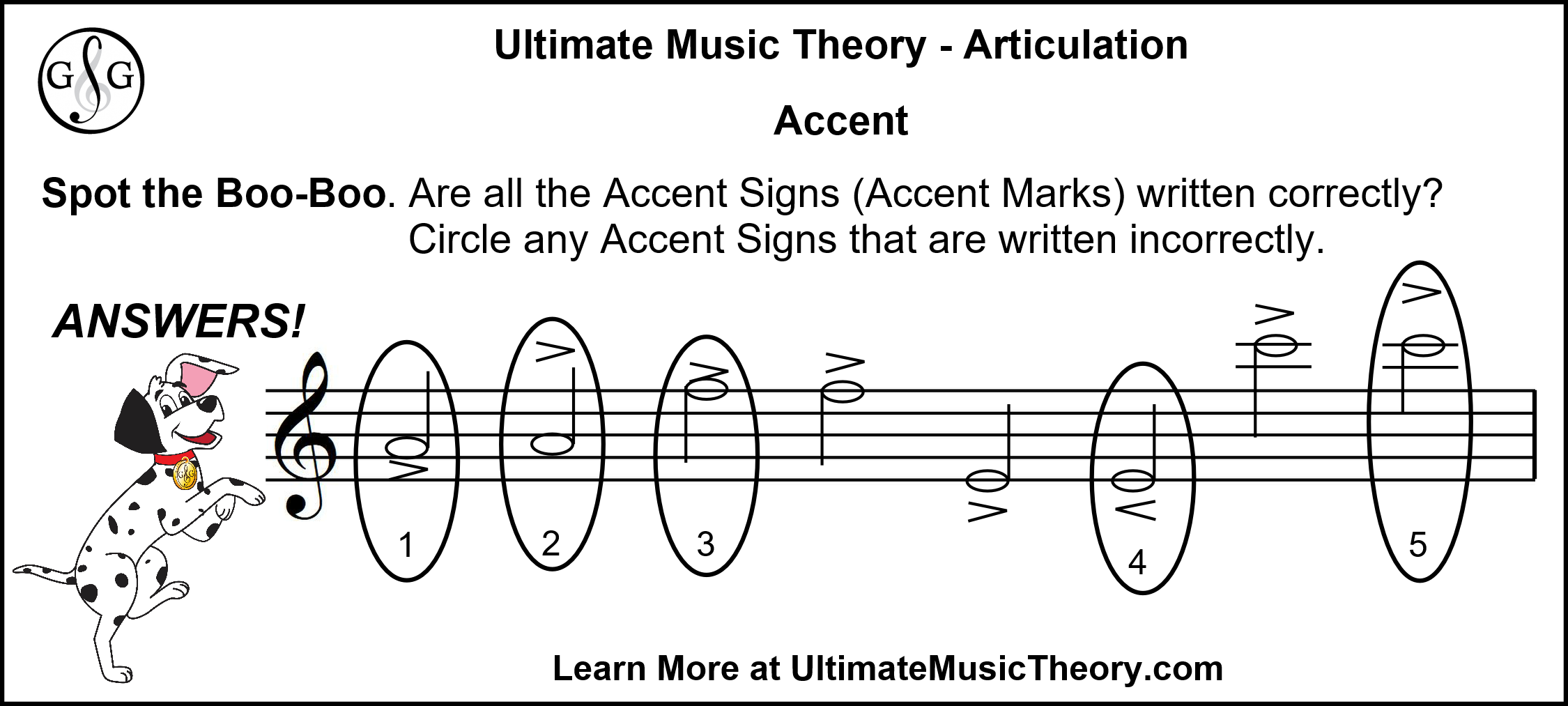
Articulation - Accent - Spot the Boo-Boo Answers
Here are the reasons why the 5 circled notes are incorrect. If you did not find all 5, remember to read the Blog again. As Teachers, we need to know and understand why an answer is "incorrect".
- The accent was written in Space #1 of the Staff. This note does not meet the criteria of the "Exceptions", so the accent must be written in the space below the staff.
- The note stem is up, therefore the accent must be written in the space below the staff.
- The accent cannot touch the notehead. (If the accent touches the notehead, it is incorrect.)
- The accent sign itself was written backwards (as a "less than" sign).
- The accent is significantly too far away from the notehead. The first "empty space" above this notehead is not a huge leap up! Did you notice the Bonus Boo-Boo here? Does the stem follow the "stem rule" for notes on Ledger Lines?
When a Student argues "I was close enough though", I tell them about the time my Amazon Package was delivered to my neighbour (#1177 Cuthbertson) and not to me (#1179 Cuthbertson). If Amazon told me "this was close enough to your address", I would not be a happy camper. "Close enough" is incorrect. (By the way, my awesome neighbour brought the package over to me right after it was delivered.)
If you are an Ultimate Music Theory Member, you can also download free Worksheets and Answer Sheets for this Blog:
- Worksheet #1 - Articulation - Accents - Add the Stems and the Accents;
- Worksheet #2 - Articulation - Accents - Ledger Lines, Stems and Accents.
By adding that extra concept of "adding the stems", Students get to review the Stem Rule. This Rule is taught on page 40 in the Ultimate Music Theory Prep 1 Rudiments Workbook. I love the "pizza and donuts" memory jogger here too.
I hope that you learned something new about Accents!
Ultimate Music Teachers Membership
♪ LEARN ♪ PLAN ♪ TEACH ♪ GROW
The One & ONLY Ultimate Music Teachers Membership
To Become A UMT PRO!
Your Success Path Starts Here - Go To TeachUMT.com Today!
Keep on Learning... With a Smile and a Song!
Shelagh McKibbon-U'Ren


